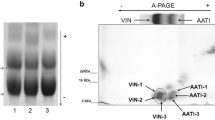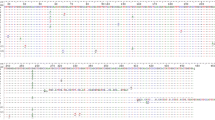Abstract
Among cereals, Avena sativa is characterized by an extremely soft endosperm texture, which leads to some negative agronomic and technological traits. On the basis of the well-known softening effect of puroindolines in wheat kernel texture, in this study, indolines and their encoding genes are investigated in Avena species at different ploidy levels. Three novel 14 kDa proteins, showing a central hydrophobic domain with four tryptophan residues and here named vromindoline (VIN)-1,2 and 3, were identified. Each VIN protein in diploid oat species was found to be synthesized by a single Vin gene whereas, in hexaploid A. sativa, three Vin-1, three Vin-2 and two Vin-3 genes coding for VIN-1, VIN-2 and VIN-3, respectively, were described and assigned to the A, C or D genomes based on similarity to their counterparts in diploid species. Expression of oat vromindoline transgenes in the extra-hard durum wheat led to accumulation of vromindolines in the endosperm and caused an approximate 50 % reduction of grain hardness, suggesting a central role for vromindolines in causing the extra-soft texture of oat grain. Further, hexaploid oats showed three orthologous genes coding for avenoindolines A and B, with five or three tryptophan residues, respectively, but very low amounts of avenoindolines were found in mature kernels. The present results identify a novel protein family affecting cereal kernel texture and would further elucidate the phylogenetic evolution of Avena genus.




Similar content being viewed by others
References
Anderson DD, Greene FC, Yip RE, Halford NG, Shewry PR, Malpica-Romero JM (1989) Nucleotides sequences of the two high-molecular-weight glutenin genes from the D-genome of a hexaploid bread wheat, Triticum aestivum L. cv Cheyenne. Nucleic Acids Res 17:461–462
Ausubel FM, Brent R, Kingston RE, Moore DD, Seidman JG, Smith JA, Struhl K (1994) Genomic extraction using the modified CTAB method. Current protocols in molecular biology. Wiley, New York
Bhave M, Morris CF (2008) Molecular genetics of puroindolines and related genes: regulation of expression, membrane binding properties and applications. Plant Mol Biol 66:221–231
Blochet JE, Chevalier C, Forest E, Pebay-Peyroula E, Gautier MF, Joudrier P, Pezolet M, Marion D (1993) Complete amino acid sequence of puroindoline, a new basic and cysteine-rich protein with a unique tryptophan-rich domain, isolated from wheat endosperm by Triton X-114 phase partitioning. FEBS Lett 329:336–340
Chantret N, Salse J, Sabot F, Rahman S, Beliec A, Laubin B, Dubois I, Dossat C, Sourdille P, Joudrier P, Gautier MF (2005) Molecular basis of evolutionary events that shaped the hardness locus in diploid and polyploid wheat species (Triticum and Aegilops). Plant Cell 17:1033–1045
Chen F, He ZH, Xia XC, Lillemo M, Morris CF (2005) A new puroindoline b mutation present in Chinese winter wheat cultivar Jingdong 11. J Cereal Sci 42:267–269
Clifton LA, Lad MD, Green RJ, Frazier RA (2007) Single amino acid substitutions in puroindoline-b mutants influence lipid binding properties. Biochem 46:2260–2266
Corona V, Gazza L, Boggini G, Pogna NE (2001) Variation in friabilin composition as determined by A-PAGE fractionation and PCR amplification, and its relationship to grain hardness in bread wheat. J Cereal Sci 34:243–250
Dexter JE, Preston KR, Martin DG, Gander EJ (1994) The effects of protein content, and starch damage on the physical dough properties and breadmaking quality of Canadian durum wheat. J Cereal Sci 20:139–151
Egorov TA, Odintsova TI, Musolyamov AKh, Fido R, Tatham AS, Shewry PR (1996) disulphide structure of a sunflower seed albumin: conserved and variant disulphide bonds in the cereal prolamin superfamily. FEBS Lett 396:285–288
Evrard A, Lagarde V, Joudrier P, Gautier M-F (2008) Puroindoline-a and puroindoline-b interact with Saccharomyces cerevisiae plasma membrane through different amino acids present in their tryptophan-rich domain. J Cereal Sci 48:379–386
Gautier MF, Cosson P, Guirao A, Alary R, Joudrier P (2000) Puroindoline genes are highly conserved in diploid ancestor wheats and related species but absent in tetraploid Triticum species. Plant Sci 153:81–91
Gazza L, Nocente F, Ng PKW, Pogna NE (2005) Genetic and biochemical analysis of common wheat cultivars lacking puroindoline a. Theor Appl Genet 110:470–478
Gazza L, Conti S, Taddei F, Pogna NE (2006) Molecular characterization of puroindolines and their encoding genes in Aegilops ventricosa. Mol Breed 17:191–200
Giroux MJ, Morris CF (1998) Wheat hardness results from highly conserved mutations in the friabilin components puroindolines a and b. Proc Nat Acad Sci USA 95:6262–6266
Greenblatt GA, Bettge AD, Morris CF (1995) The relationship among endosperm texture, friabilin occurrence, and bound polar lipids on wheat starch. Cereal Chem 72:172–176
Gudmundsson M, Eliasson AC (1989) Some physico-chemical properties of oat starches extracted from varieties with different oil content. Acta Agric Scand 39:101–111
Hansen HB, Møller B, Andersen SB, Jørgensen JR, Hansen A (2004) Grain characteristic, chemical composition, and functional properties of rye (Secale cereale L.) as influenced by genotype and harvest year. J Agric Food Chem 52:2282–2291
Iwami A, Osborne BG, Huynh H-N, Andersen RS, Wesley IJ, Kajiwara Y, Takashita H, Omori T (2005) The measurement of structural characteristics of barley for Shochu using Single-kernel characterization system 4100 crush-response profiles. J Inst Brew 111:181–189
Janni M, Sella L, Favaron F, Bleachl AE, De Lorenzo G, D’Ovidio R (2008) The expression of a bean pgip in transgenic wheat confers increased resistance to the fungal pathogen Bipolaris sorokiniana. MPMI 21:171–177
Jellen EN, Gill BS, Cox TS (1994) Genomic in situ hybridization differentiates between A/D- and C-genome chromatin and detects intergenomic translocation in polyploid oat species (genus Avena). Genome 37:613–618
Knowlton KF, Allen MS, Erickson PS (1996) Lasalocid and particle size of corn grain for dairy cows in early lactation.1. Effect on performance, serum metabolite, and nutrient digestibility. J Dairy Sci 79:557–564
Ladizinsky G (1998) A new species of Avena from Sicily, possible the tetraploid progenitor of hexaploid oats. Genet Res Crop Evol 45:263–269
Li PX-P, Hardacre AK, Campanella OH, Kirkpatrick KJ (1996) Determination of endosperm characteristics of 38 corn hybrids using the stenvert hardness test. Cereal Chem 73:466–471
Lillemo M, Simeone MC, Morris CF (2002) Analysis of puroindoline a and b sequences from Triticum aestivum cv. ‘Penawawa’ and related diploid taxa. Euphytica 126:321–331
Linares C, Ferrer E, Fominaya A (1998) Discrimination of the closely related A and D genomes of the hexaploid oat Avena sativa L. Proc Nat Acad Sci USA 95:12450–12455
Lindahl L, Eliasson A-C (1992) A comparison of some rheological properties of durum and wheat flour doughs. Cereal Chem 69:30–34
Massa AN, Morris CF (2006) Molecular evolution of the puroindoline-a, puroindoline-b, and grain softness protein-1 genes in the tribe Triticeae. J Mol Evol 63:526–536
Massa AN, Morris CF, Gill BS (2004) Sequence diversity of Puroindoline-a, Puroindoline-b, and the grain softness protein Genes in Aegilops tauschii coss. Crop Sci 44:1808–1816
Mohammadi M, Abbas Zaidi M, Ochalski A, Thanchak M, Altosaar I (2007) Immunodetection and immunolocalization of tryptophanins in oat (Avena sativa L.) seeds. Plant Sci 172:579–587
Nikoloudakis N, Katsiotis A (2008) The origin of the C genome and cytoplasm of Avena polyploids. Theor Appl Genet 117:273–281
Pedersen JF, Martin CR, Felker FC, Steele JL (1996) Application of the single kernel wheat characterization technology to sorghum grain. Cereal Chem 73:421–423
Peltonen-Sainio P, Muurinen S, Vilppu M, Rajala A, Gates F, Kirkkari AM (2001) Germination and grain vigour of naked oat in response to grain moisture at harvest. J Agric Sci 137:147–156
Peterson DM (1992) Composition and nutritional characteristics of oat grain and products. Oat science and Technology. Marshall HG and Sorrels ME (Co-Eds) Madison, USA, pp 265–292
Peterson DM (2004) Oat—a multifunctional grain. In: Proceedings 7th Int Oat Conference. Pelton-Sainio P and Topi-Hulmi M (Eds). MTT Agrifood Research Finland, pp 21–26
Pogna NE, Gazza L, Corona V, Zanier R, Niglio A, Mei E, Palumbo M, Boggini G (2002) Puroindolines and kernel hardness in wheat species. In: Ng PKW, Wrigley CW (eds) Wheat quality elucidation: the Bushuk legacy. AACC, Inc., St. Paul, pp 155–169
Rahman S, Jolly GJ, Skerritt JH, Waelosheck A (1994) Cloning of a wheat 15-KDa grain softness protein (GSP). J Biochem 223:917–925
Rajhathy T, Thomas H (1974) Cytogenetics of oats (Avena L.). Misc Publ Genet Soc Can 2:1–90
Redaelli R, Sgrulletta D, Scalfati G, De Stefanis E, Conciatori A, Cammerata A, Pollini CM (2005) L’avena per un prodotto alimentare ricco di proprietà salutari. Risultati della ricerca in Italia. Tecnica Molitoria 3:257–267 (In Italian)
Rondanelli M, Opizzi A, Monteferraio F (2009) The biological activity of beta-glucans. Minerva Med 100:237–245
Shevchenko A, Wilm M, Vorm O, Mann M (1996) Mass spectrometric sequencing of proteins from silver-stained polyacrylamide gels. Annal Chem 68:850–858
Taddei F, Gazza L, Conti S, Muccilli V, Foti S, Pogna NE (2009) Starch-bound 2S proteins and kernel texture in einkorn, Triticum monococcum ssp monococcum. Theor Appl Genet 119:1205–1212
Tanchak MA, Schernthaner JP, Giband M, Altosaar I (1998) Tryptophanins: isolation and molecular characterization of oat cDNA clones encoding proteins structurally related to puroindoline and wheat grain softness proteins. Plant Sci 137:173–184
Thomas H (1992) Cytogenetics of Avena. In: Oat science and technology. Marshall HG and Sorrells ME (Eds). Agron Monogr 33. ASA and CSSA, Madison, WI, pp 473-507
Tosi P, D’Ovidio R, Napier JA, Bekes F, Shewry PR (2004) Expression of epitope tagged LMW glutenin subunits in the starchy endosperm of transgenic wheat and their incorporation into glutenin polymers. Theor Appl Genet 108:468–476
Valentine J (1995) Naked oats. In: Welch RW (ed) The oat crop: production and utilization. Springer, Netherlands, pp 504–532
Valentine J, Hale OD (1990) Investigations into reduced germination of seed of naked oats. Plant Var Seed 3:21–30
Wilkinson M, Wan Y, Tosi P, Leverington M, Snape J, Mitchell RAC, Shewry PR (2008) Identification and genetic mapping of variant forms of puroindoline b expressed in developing wheat grain. J Cereal Sci 48:722–728
Wondra KJ, Hancock JD, Behnke KC, Hines RH, Stark CR (1995) Effects of particle size and pelleting on growth performance, nutrient digestibility, and stomach morphology in finishing pigs. J Anim Sci 73:757–763
Zhou M, Robards K, Glennie-Holmes M, Helliwell S (1998) Structure and pasting properties of oat starch. Cereal Chem 75:273–281
Author information
Authors and Affiliations
Corresponding author
Electronic supplementary material
Online Resource 1 DNA construct obtained by insertion of the coding region of Vin-D2a (JQ518369) or Vin-A3a (JQ518372) between the Dx5Prom promoter and the Dx5T terminator of gene Glu-D1-1a at the SalI and Xba sites of the pRDPT5 plasmid.
Online Resource 2 (A) Two-dimensional A-PAGE x SDS-PAGE fractionation of starch-bound proteins from oat cv. Primula and (B) immunostaining with the polyclonal antiserum specific to protein 3B3.
Online Resource 3 Agarose gel fractionation of cDNA amplicons obtained with primers specific to (A) Vin-2 (B) Vin-3 and (C) Aina in immature kernels of oat cv. Donata. Immature kernels were harvested 7, 14, 21, 28 and 35 days post anthesis (DPA). Tub = amplicons of oat β-tubulin.
Online Resource 4 (A) A-PAGE fractionation of starch-bound proteins extracted from immature kernels harvested 7, 14, 21, 28 and 35 DPA from oat cv. Donata and (B) immunostaining with the polyclonal antiserum specific to VIN-2 (3B3). Mat: mature kernels (> 45 DPA). VIN = vromindolines.
Online Resource 6 Starch-bound proteins fractionated by A-PAGE and immunostained with the anti-VIN-3 (anti-3B3T) antibody. Kernels from: (1,2) T1 plants homozygous for Vin-D2a and Vin-A3a; (3) null T1 plant; (4,5) T1 plants homozygous for Vin-D2a and Vin-A3a; (6) A. sativa cv. Donata and (7) durum wheat cv. Svevo.
Below is the link to the electronic supplementary material.
Rights and permissions
About this article
Cite this article
Gazza, L., Taddei, F., Conti, S. et al. Biochemical and molecular characterization of Avena indolines and their role in kernel texture. Mol Genet Genomics 290, 39–54 (2015). https://doi.org/10.1007/s00438-014-0894-5
Received:
Accepted:
Published:
Issue Date:
DOI: https://doi.org/10.1007/s00438-014-0894-5




